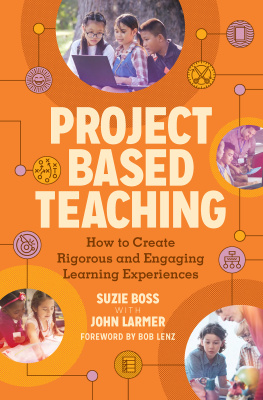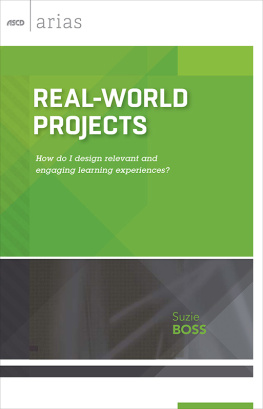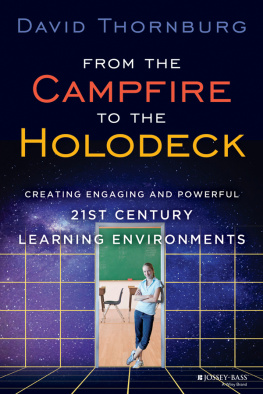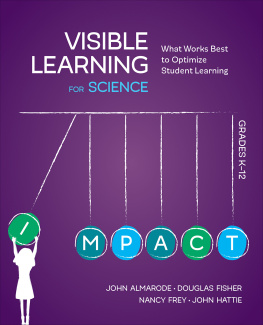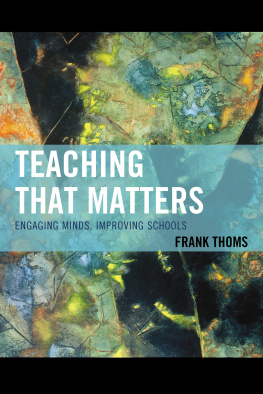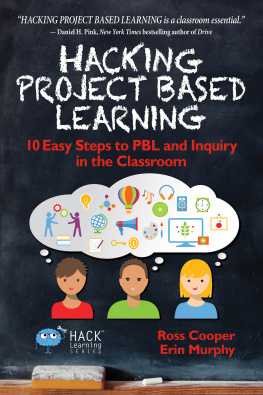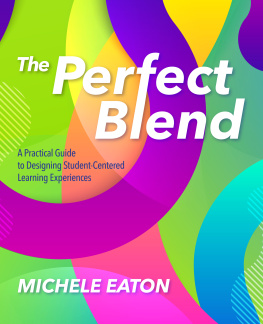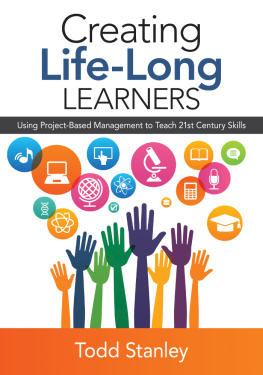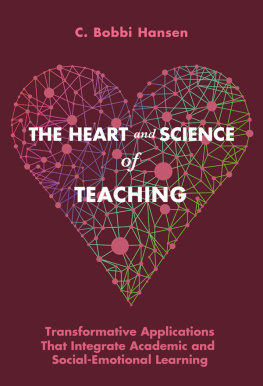Contents
Guide
Pages
Dedication
....................
To the talented and dedicated National Faculty of the Buck Institute for Education
Acknowledgments
....................
This book would not have been possible without the contributions of many talented and thoughtful educators.
John Mergendoller laid the foundation when he promoted the need to focus on the role of the teacher in Project Based Learning (PBL) and collaborated with John Larmer to conceptualize the Gold Standard PBL model's Essential Project Design Elements and the Project Based Teaching Practices. Mergendoller's insightful feedback on early drafts of this book helped us keep the focus on what matters most for high-quality teaching and learning.
Dozens more individuals shared practical strategies, informed by extensive classroom experiences. In particular, we are indebted to the Buck Institute for Education (BIE) National Faculty. These educators, working in diverse contexts across the United States (and beyond), live and breathe PBL every day as teachers, instructional coaches, school leaders, and professional development experts. Their suggestions and insights can be found in every chapter.
BIE staff shaped the book in significant ways, from early brainstorming to critique and review of draft chapters. Many of the tools and strategies featured in the book are the result of staff creativity and collaboration, particularly by Sarah Field and Gina Olabuenaga, who manage the creation of BIE's PBL 201 workshops.
We owe special thanks to seven teachers who opened their classrooms for close observation and reflection while projects were underway with students. Their stories and advice are woven throughout this book and also captured in a companion set of videos. Featured teachers include Telannia Norfar, Ray Ahmed, Rebecca Newburn, Erin Brandvold, Sara Lev, Kimberly Head-Trotter, and Cheryl Bautista.
We learned more about Project Based Teaching from dozens of interviews and blog posts shared by these PBL veterans: Feroze Munshi, Sherry Griesinger, Myla Lee, Abby Schneiderjohn, Erin Gannon, Ian Stevenson, Brandon Cohen, Julia Cagle, Tom Lee, Eric White, Krystal Diaz, Jim Bentley, Meghan Ashkanani, Mike Gwaltney, Dara Laws Savage, Mike Kaechele, Kevin Gant, James Fester, Tyler Millsap, Scott Stephen Bell, Kelly Reseigh, Tom Neville, Andrew Miller, John McCarthy, Kristin Uliasz, Erin Starkey, Heather Wolpert-Gawron, and Brian Schoch. Forgive us for any omissions.
Equity is a theme that permeates this book. It's our shared belief that all students, regardless of ZIP code, deserve opportunities for the meaningful, engaging learning that happens in Gold Standard PBL. We thank the many fellow travelers, too numerous to list here, who are creating transformative learning opportunities for their students.
Finally, we thank editor Genny Ostertag and her team at ASCD for encouraging us to bring this book to readers.
Foreword
by Bob Lenz
Executive Director, Buck Institute for Education
....................
The world has changed dramatically over the last generationeven over the last 10 years. Our lives have become far more connected through technology, a global economy, and social media. Our awareness of the complexity of the challenges we face as human beingsfrom climate change to issues of conflict and food distributionhas grown substantially. The world of work is changing rapidly, too. More and more tasks are being automatedfrom manufacturing to driving to writing data-based reports. Furthermore, collaboration has become the norm; most people in Information Age companies work in and across teams. Finally, it has become a project-based world. Forty percent of people in the United States work as contract employees, moving from one client's project to another. This is expected to grow to 60 percent by 2025. Almost all work, even in traditional companies, is organized by projects. Given the dramatic changes in the world, one would think that schools have also changed. Yet, for the most part, we educate our youth the same way we did over 100 years ago.
Over the last three years, I have had the opportunity to ask people all over the worldyoung and old, educators and business leaders, community leaders and parentsthis question: "Given the changes in the world, what skills and dispositions are needed for success?" Amazingly, no matter where I asked the question, among all groups, I found consensus on the answer. In addition to academic content knowledge and skills, students need success skills such as collaboration, communication (oral, written, and visual), critical thinking and problem solving, project management and self-management, creativity and innovation, and a sense of empowerment to tackle the challenges of their lives and our world. The students experiencing the kind of Project Based Learning described in this book are gaining these skills and dispositions.
The Need for Project Based Teaching
Though we all agree that the world has changed, we also know that schools have not. With this growing awareness, we have started to see some shifts around the United States and globally. We see schools and districts working toward more student-centered approaches that include inquiry learning, personalized learning, performance-based assessments, and a huge surge of interest in and implementation of Project Based Learning. To meet the demand for examples of projects and PBL professional development for teachers, the field has responded.
Examples of high-quality projects can be found in many places, and due to the excellent work of my colleagues at the Buck Institute for Education and other education organizations focused on deeper learning, teachers can access materials, resources, and workshops on how to design high-quality projects. The Essential Project Design Elements in the Buck Institute's model for Gold Standard PBL, first described in Setting the Standard for Project Based Learning (Larmer, Mergendoller, & Boss, 2015), have been well received and adopted by educators across the country and around the world. The Project Based Teaching Practices also introduced in that book have equally resonated with the field; however, more is needed about how to teach in a PBL classroom.
Educators need detailed descriptions, strategies, and video so they can learn about the teacher moves that lead to effective implementation of PBL. Project Based Teaching, plus a series of videos released by the Buck Institute for Education, answers this call by highlighting the work of seven diverse and successful PBL teachers. Several more teachers are heard from in this book, many of whom are in the Buck Institute's National Faculty. These teachers are not necessarily the "rock stars" you might see in popular movies; they are regular folks who are nonetheless inspirational for their classroom skills, depth of knowledge, and passion for doing a good job for all kids.
How School and District Leaders Create the Conditions for Project Based Teaching
Whereas Project Based Teaching focuses on the nitty-gritty of how teachers facilitate high-quality learning experiences for students, the work of school and district leaders to put the conditions in place for teachers to do great projects with kids cannot be overlooked. In the schools where we see excellent implementation of Project Based Learning, we also find

